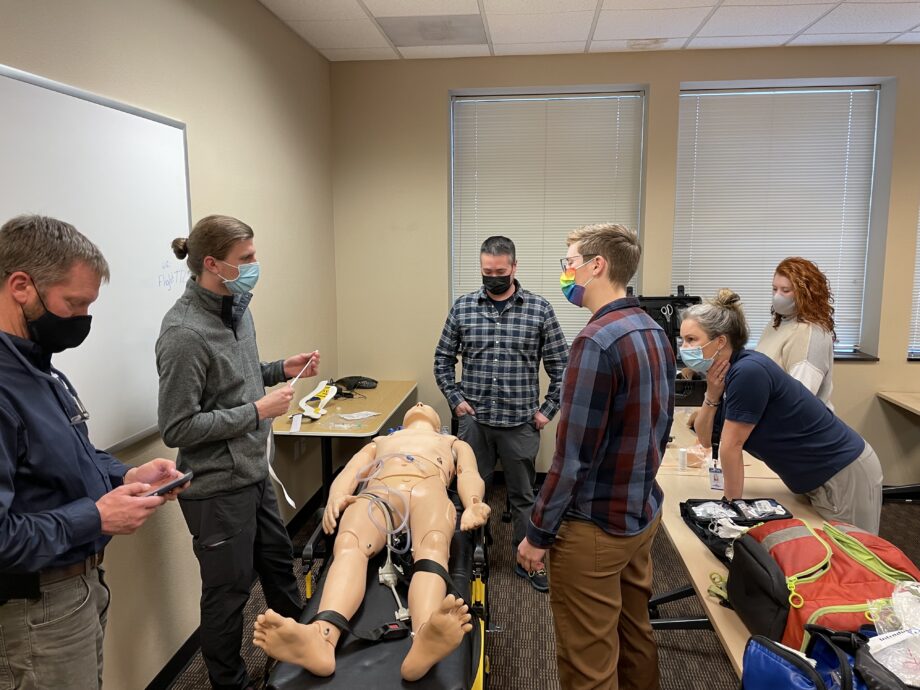This article and accompanying webinar presentation provide an opportunity for Life Flight Network to share our journey and lessons learned during the initial and ongoing COVID-19 pandemic response. Join us as we discuss how Life Flight Network discovered how unprecedented creativity, breaking down complex systems, and minimizing hierarchies were necessary agents during a pandemic response.
Moreover, an important aspect of the organizational response is the ability to pivot from a reactive model to planning and predictive models. These models enabled Life Flight Network to obtain and analyze data, improve the supply chain, secure and distribute PPE and build a robust surveillance and reporting system.
Key Takeaways:
- Life Flight Network experienced no interruption in service during the COVID-19 pandemic
- Life Fight Network provided quality and safe patient care for our patients
- Life Flight Network used best practices based upon the most up-to-date medical research
Objectives:
- Understand the importance of a multi-departmental approach to maintaining resilience and building capacity
- Learn the importance of pivoting from a reactive to a planning model during a health crisis
- Understand how to disassemble complex systems and implement strategies to build capacity
- Describe the value of designing a novel data reporting and analytics dashboard
- Describe the value of understanding exponential growth during the early phase of an emerging pandemic
Our discussion will describe Life Flight Network’s initial and ongoing response during the COVID-19 pandemic. A multi-department collaboration was used and included: Business Intelligence, Customer Service, QM, Safety, Supply Chain, and Clinical. These departments worked together to obtain and redesign our PPE supply chain and distribution, vehicle decontamination, tracking and reporting of COVID-19-positive patient transports, and crew exposure surveillance.
Panelists will describe in detail why it was important to design and implement a COVID-19 dashboard and how this organization used real-time data to drive decisions. Our COVID-19 dashboard and data collection and reporting tools were both critical and timely interventions for Life Flight Network’s initial and ongoing response.
The design and implementation of our novel COVID-19 dashboard and reporting methods provided real-time data related to patient transports and surveillance, along with PPE supply chain and inventory. The dashboard calculated the average rate of PPE used by base and transport.
Timely reporting and tracking COVID-19 PUIs and COVID-19-positive patient transports was an essential element of Life Flight Network’s initial response to the COVID-19 pandemic. Once the COVID-19 status of our patients was determined the results were entered into the QM reporting system and the crews received feedback regarding the patient’s COVID-19 status usually within 48 hours. A robust surveillance system allowed the identification of COVID-19 patients and potential crew exposure which supported safe and uninterrupted operations.
Other important discussion topics include:
Life Flights Network’s After-Action Review
On August 25, 2021, Life Flight Network held an After Action Review (AAR). Fifteen departments were represented and reported on what went well, what didn’t go well, opportunities for improvement, lessons learned, and system improvements that were implemented. We identified eight common themes of went well and seven common themes of things that didn’t go well. Or just went wrong. These notes were memorialized and distributed in our AAR report.
Global COVID-19 Response and Lessons Learned
The Independent Panel for Pandemic Preparedness and Response (IPPPR), a team of experts convened by the World Health Organization’s member states last May to review the world’s handling of the crisis, found weak links at every point in the chain of preparedness and response. “Preparation was inconsistent and underfunded,” the panel said in a report. “The alert system was too slow—and too meek. The World Health Organization was underpowered. The response has exacerbated inequalities. Global political leadership was absent.” “Too many countries took a ‘wait and see’ approach rather than enacting an aggressive containment strategy that could have forestalled the global pandemic.”
Conclusion
We live in a world of crisis and complacency. During a pandemic, we are in the moment (serious, concerned, engaged, and adaptive) however, when the crisis is over we can quickly become complacent. Why? We are quick to return to normal, to delay the repair, to claim we don’t have the emotional resources or societal bandwidth, or funding to make the necessary changes and plan for our future. If this is truly the cycle in which we live (crisis and complacency) – then we will not be better prepared for the next pandemic.
Knowing this, what is your plan? Think about how you will respond, how prepared you want to be, need to be – How you will protect yourself, your family, friends, community, and healthcare institutions to safely navigate the next pandemic.
Let’s have a plan – let’s not forget the valuable lessons learned from COVID-19.
Susan Gidding MHS, RN, RRT Director Life Flight Network
Reference:
Thought Leadership Series – Escape Fire Article 05272022
